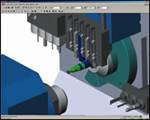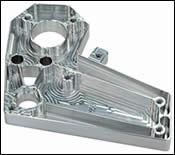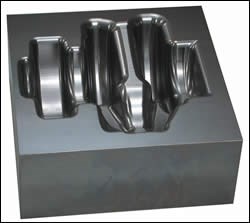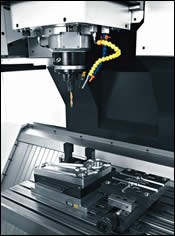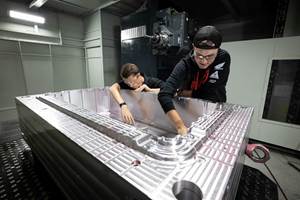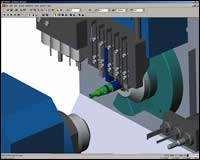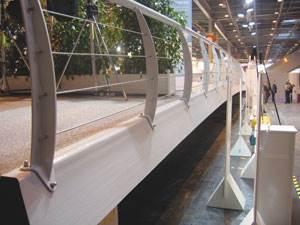Intelligent Machining Software to Increase Surface Finish and Productivity in Mold Mfg
Progress in the realm of software offers moldmakers the opportunity to maximize the potential of their machining processes when it comes to maintaining extremely high surface finishes.
With the constantly increasing pressure of global competition, today’s moldmakers face the challenge of achieving greater productivity, while maintaining extremely high surface finishes. There has always been a trade-off between accuracy, surface finish and cutting speed, where making one a priority can detrimentally affect the other two. Even with the advancements seen in machine technology, that dilemma still exists. Fortunately, progress in the realm of software offers moldmakers the opportunity to maximize the potential of their machining processes.
Minimizing the Effects of Vibration
Traditionally, one of the largest barriers to achieving high surface finish has been vibration. Considering the whole spindle system, vibrations can be induced by several different components. Whether looking at the concentricity quality and balancing of the tool, toolholder system type, spindle interface or interface diameter, there is an intrinsic vibration existing within the system itself. Part clamping, pallet systems and the geometry of the mold being machined also can influence vibration.
Additionally, there are real-time vibrations generated by the milling process itself—placing considerable radial forces on the spindle system and adversely affecting the ability to maintain high surface finishes.
While intrinsic vibrations can be minimized through the proper selection and balancing of tools and toolholders, the vibration generated by the cutting process itself varies largely by application. Fortunately, tools now exist to help moldmakers analyze and eliminate this variable.
Through combinations of software and hardware, today’s moldmakers have an unprecedented ability to precisely monitor levels of vibration throughout the machining of a mold. For example, some machine spindles1 contain a built-in radial acceleration sensor called an Advanced Process System. In combination with software installed on the machine, this allows the generation of a graphical representation of vibration. Systems such as this provide tremendous value.
On a series of identical workpieces, vibration data monitoring can be used to optimize the process and make it more reliable. By using this information, machine operators can fine tune the machining process and define the maximum levels of vibration allowable to maintain the needed surface finish. These levels of deviation can be programmed into the software so that the machine generates a warning or shuts down if they are exceeded.
Whenever variables arise that begin to cause levels of vibration that will result in unacceptable surface finishes, the operator receives instant notification. This helps optimize performance and allows the machine to run at its maximum productivity, while guaranteeing the surface finish quality required by the mold.
Optimizing Machine Dynamics
Machine controls today allow for extensive dynamic tuning of machine performance. The most common values to look at when considering machine dynamics are speed and acceleration. Equally important as each of these is jerk.
Jerk describes how quickly the nominal acceleration is reached. The higher the jerk, the faster the rate of acceleration. A machine’s jerk is limited by its mechanical structure and stiffness. Higher jerk makes the movement of the axes much more aggressive. While this increases productivity, it also can introduce vibration that negatively affects surface finish or accuracy.
Achieving the best possible dynamic tuning of a machine is a matter of finding the optimal compromise between speed, accuracy and surface finish. Usually, these judgments are made by the operator. In a roughing operation, it would make sense to maximize speed and pay less attention to accuracy and surface finish. In semi-finishing and finishing operations, the opposite would hold true. The maximization of machine dynamics by application has traditionally relied heavily on the knowledge of the operator.
Today, many machine builders are beginning to offer software that simplifies the adjustment of machine dynamics. For instance, an Operator Support System has been developed2 whose software shows a triangle including speed, accuracy and surface finish. Users can easily adjust priorities and the software calculates optimal dynamic performance of the machine as dictated by a job’s specific requirements.
Software such as the aforementioned can provide tremendous benefit in achieving high surface finishes while still getting the maximum levels of productivity out of a machine. In best case scenarios, the software not only takes into account the machine itself, but also the weight of the workpiece and tooling, toolpaths and other variables specific to a part. This ensures the surface finish required by a mold, without an unnecessary compromise of productivity.
What the Future Holds
Already, machine builders have taken dramatic steps in developing software to help moldmakers optimize their machining processes. Further advancements will soon continue this development.
In the realm of minimizing vibration, current software exists mostly as a reactive tool. It provides tremendous value, but the machine operator must make judgments and set parameters based upon the feedback given by the software. The next evolutionary step in smart software will allow the machine to act much more proactively.
For instance, when vibration levels begin to increase, the machine will automatically vary spindle speeds and feedrates to bring them back down into an acceptable range. Software also will likely contain the ability to slightly alter machine programs, analyze the resulting vibration rates throughout a job and suggest an optimal solution.
While many mold manufacturers pay close attention to the benefits afforded by advancements in machine hardware, progress in the realm of software also provides significant opportunity for process improvement. By understanding and taking advantage of the latest software technologies, moldmakers will be able to get the most out of their machine investments, achieving the perfect balance of surface finish and productivity.
1,2 GF AgieCharmilles.
Related Content
How to Analyze and Optimize Cutting Conditions to Reduce Cycle Time
Plastic injection mold design and manufacturing company puts NC program optimization software module to the test. The results were surprising.
Read MoreSpeed, Productivity Gains and High Uptime Ease Decision for Second Five-Axis Machine
Byrne Tool + Design reduced setups and gained speed and productivity thanks to fast, accurate and compact five-axis CNC machining centers.
Read MoreHybrid Milling/Drilling Machine Reduces Total Mold Machining Time
MSI Mold Builders now squares, plus drills and taps eye-bolt holes on 50% of its tools in a single setup using a five-axis milling/drilling center with a universal spindle.
Read MoreFive-Axis Vertical Mill Increases Mold Shop Capacity by Reducing Setups
Zero Tolerance now processes blocks — from squaring to waterline drilling to rough and finish milling — on a single five-axis CNC mill, reducing setups and moving blocks in/out of multiple machines without sacrificing accuracy and surface finish.
Read MoreRead Next
CAM Technology Trends
More than the products themselves, the CAM industry is changing the way it does business and moldmakers should take note.
Read MoreRediscovering CAM
Exploring underused CAM features that can improve moldmaking productivity and trim operating costs.
Read MoreAre You a Moldmaker Considering 3D Printing? Consider the 3D Printing Workshop at NPE2024
Presentations will cover 3D printing for mold tooling, material innovation, product development, bridge production and full-scale, high-volume additive manufacturing.
Read More
